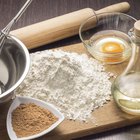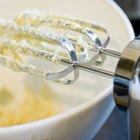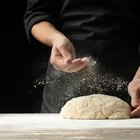
Jupiterimages/Polka Dot/Getty Images
Baking powder is a leavening agent that helps cakes, cookies and quick breads rise. The word "leavening" comes from an Indo-European word meaning "light, having little weight." Without leavening, baked goods are dense and heavy. Sodium aluminum phosphate is one of the ingredients in baking powder that creates the necessary carbon dioxide bubbles in doughs and batters, according to David Brooks, Ph.D., professor of Chemistry Education at the University of Nebraska. This action helps dough rise and become light in texture. There are other ingredients in baking powder that work along with sodium aluminum phosphate.
Why Use Baking Powder
Baking powder is a chemical leavening agent that works well with runny batters where yeast would not be effective. This is because yeast cells produce carbon dioxide bubbles slowly, over an hour, and they need a stiff and elastic dough to retain the bubbles created. Runny batters or weak doughs can't hold bubbles for that long, and therefore need a fast-acting gas source. This is where baking powder has power to raise batters and doughs. Baking powders are complete leavening agents because they contain both an alkaline agent -- also called a base -- such as baking soda, and a powdered acid, such as aluminum phosphate. This makes them good leavening agents for batters that are either acidic or alkaline. Baking soda only works for doughs and batters that contain acids to react with it.
Acid Components of Baking Powder
Baking powder has a chemical leavening agent that is an acid that will react with alkaline mixtures to produce carbon dioxide bubbles. There are several different kinds of leavening acids, such as cream of tartar, monocalcium phosphate, sodium aluminum pryophospate, sodium aluminum sulfate and sodium aluminum phosphate, according to Harold McGee, author of "On Food and Cooking." Each of these chemicals begins the reaction of producing carbon dioxide at different times and temperatures. Cream of tartar reacts immediately upon mixing with an alkaline batter. Sodium aluminum sulfate is slow release and heat activated. Sodium aluminum phosphate begins to produce bubbles early in cooking, at temperatures of 100 degrees Fahrenheit. This makes it good for batters and doughs that will not be cooked immediately. You can mix it up and leave it for an hour, and it will still rise once you begin to cook it.
Ingredients
Baking powders are not all the same. But essentially, they have an acid leavening agent, an alkaline or base leavening agent and a filler. The filler is usually cornstarch and is added to make it easier to measure the baking powder and to keep it from absorbing moisture. Most baking powders are "double-acting," meaning they produce an initial set of carbon dioxide bubbles upon mixing with a batter, and then a second set during the baking process. This is because of the nature of the different chemical compounds in the baking powder.
How to Use
Baking powders work in many recipes to create light products. Pancakes, waffles, quick breads, muffins and cakes rely on baking powder to make them rise. Baking powder effects the texture, moisture and flavor of the final product. Too much baking powder can leave a cake with an astringent or bitter taste. Be sure to follow directions and mix the batters thoroughly to incorporate the baking powder. Another problem with using too much baking powder is that the bubbles become too big and rise to the top of the cake, popping and then causing the cake to sink. Baking powders have an expiration date; always check for freshness before using. Store at room temperature in a dry place, away from a heat source. Keep airtight to reduce the chances of it becoming in contact with moisture. If it has lumps in it, is no good.
Related Articles
Baking Soda or Baking Powder to Make a ...

How to Make Nice Fluffy Pancakes With ...

What Can You Substitute for Baking ...

Can I Save a Cake if I Added Too Much ...

Corn Huskers Lotion Ingredients

Can Self Rising Flour Substitute for ...

How to Stop Cakes From Dropping

How to Bake With Besan Flour

The Cream for My Tiramisu Is Too Watery

A List of Leavening Agents

Heavy Whipping Cream Vs. Half & Half

What Are the Functions of Cream of ...

Does Baking Soda Affect the Height of a ...

A Baking Mistake of Not Separating the ...

How to Increase the Yeast Taste in Bread

Does It Matter if I Substitute Baking ...

Do You Use a Wire Whip or Flat Beater ...

Roshco Silicone Bakeware Instructions
Role of Xanthan Gum in Vegan Baking

Facts About How Baking Powder Might ...
References
- What's Cooking America: Baking Powder
- Enotes.com: Baking Powder
- On Food and Cooking; The Science and Lore of the Kitchen; Harold McGee
Writer Bio
Deila Taylor received a bachelor's degree in biochemistry from Occidental College with graduate work towards a Ph.D. in pharmacology and nutrition at the Keck School of Medicine of the University of Southern California. Taylor has written for LoopLane, The Nutrition Counselor, Eve Out of the Garden and produces interviews for The Mormon Women Project. She is a member of the American Society for Nutrition.
Photo Credits
Jupiterimages/Polka Dot/Getty Images